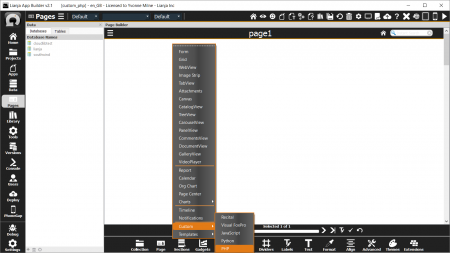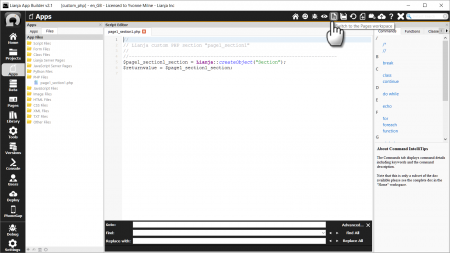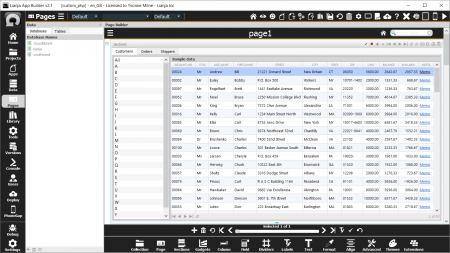Developing Custom UI Sections in PHP
Contents
- 1 About this tutorial
- 2 The Lianja App Development process
- 3 Lianja UI Framework
- 4 Building a Custom Section
- 5 Editing the Custom Section code
- 6 Using the Lianja UI Framework
About this tutorial
In this tutorial we will see how to build Custom Sections in PHP. The target audience is for intermediate developers who have read through and understood the Getting Started with Lianja tutorial.
The Lianja App Development process
As you should recall from the Getting Started with Lianja tutorial, developing apps in the Lianja App Builder is an iterative process.
Let's just quickly review that process.
- You visually build a Lianja App using the Lianja App Builder. For non-programmers, the Lianja App Builder providers a wide range of pre-built templates to assist you in building an App quickly and easily.
- Lianja Apps are made up of Pages. Pages are made up of Sections. Sections are made up of Fields and Gadgets.
- You can group pages into Page Collections.
If you require to build a more complex App with a custom UI, you do this by building Custom Sections and/or Custom Gadgets in any of the following scripting languages which are integrated into the Lianja App Builder:
- Lianja/VFP (Visual FoxPro compatible)
- JavaScript
- Python
- PHP
Seeing that the Lianja App Builder has an embedded database built into it, you do not need to install any other software to be able to build multi-user high performance database apps for the desktop, web and mobile devices.
The Lianja embedded database engine is highly compatible with Visual FoxPro. It includes a feature-complete cross platform implementation on the Visual FoxPro scripting and database engine.
Python, JavaScript and PHP are seamlessly integrated on top of this database engine, allowing you to build custom UI sections and custom UI gadgets in Visual FoxPro, JavaScript, Python or PHP and make full use of the power of this high performance database engine with local cursors and complete SQL and noSQL database support.
To facilitate the development of custom UI sections and gadgets, Lianja comes with a cross-platform, UI independent application framework called the Lianja UI Framework.
Lianja UI Framework
The Lianja UI Framework is a feature rich application framework used to build custom UI elements for the desktop, web and mobile devices. The classes, methods and properties in the framework are compatible with those in Visual FoxPro 9.0 but have been extensively extended to make it easier to build UIs for Apps that will run on the desktop, web and mobile devices. In particular, it has complete Layout Manager support, and provides the ability for each UI component to be skinned using CSS attributes (the Stylesheet property).
We recommend you use Lianja UI Layouts to help you build a responsive UI. These can be used in any of the supported scripting languages.
You use Visual FoxPro, JavaScript, Python or PHP with the Lianja UI Framework to build Custom Sections and Custom Gadgets. All Lianja UI Framework Classes provide integrated data binding to the underlying Lianja embedded database (the Controlsource property).
For details of the classes available in the Lianja UI Framework see the here.
Building a Custom Section
Let's get started and build a simple Custom Section that displays some data from a database in a Grid. Firstly, open or create an App and add a Custom Section to a blank page.
Editing the Custom Section code
To edit the code for the Custom Section move the mouse cursor over the Section header and click the Keyboard icon.
Note that you use this same procedure to edit both Custom Sections and Custom Gadgets but in the case of Gadgets you move the mouse over the gadget header.
The Apps workspace panel will then be displayed and the template code for the Custom Section will be generated and available for you to edit.
After you complete the code editing, just click on the Switch to Pages workspace toolbutton. This causes the code you edited to be saved, compiled and reloaded into the custom section on the page. You continue this process iteratively until the custom section UI is complete.
Using the Lianja UI Framework
As stated earlier you build Custom Sections and Gadgets using the Lianja UI Framework. When building a Custom Section you should subclass the Section class. When building a Custom Gadget you should subclass the Gadget class.
Creating a Custom Section
Seeing that we are building a Custom Section in this tutorial, let's take a look at the code for a Custom Section which consists of a tabbed PageFrame containing a Grid with a simple address book style navigation ListBox that populates the Grid with data when the ListBox is clicked.
//-------------------------------------------------------------------------- // // Lianja custom PHP section // //-------------------------------------------------------------------------- // Important note. In PHP to access outer variables from within class // methods you must declare them global and then specify global again // within the class method global $ui_grid; global $ui_listbox; // You can write to the console log from PHP like this Lianja::writeLog("Hello from PHP"); //-------------------------------------------------------------------------- // Step 1: Define the classes we need // Note how the Lianja UI Framework classes are subclassed in PHP // using the __construct() magic method. class mySection extends Lianja { function __construct() { parent::__construct("Section"); } function add() { Lianja::showMessage("add() was called"); } function delete() { Lianja::showMessage("delete() was called again"); } function first() { Lianja::showMessage("first() was called"); } function previous() { Lianja::showMessage("previous() was called"); } function next() { Lianja::showMessage("next() was called"); } function last() { Lianja::showMessage("last() was called"); } function watch() { Lianja::showMessage("watch() was called"); } function edit() { Lianja::showMessage("edit() was called"); } function save() { Lianja::showMessage("save() was called"); } function cancel() { Lianja::showMessage("cancel() was called"); } function refresh() { ; } } //-------------------------------------------------------------------------- // Note how the click() event handler for the Listbox is defined in PHP // just as a normal class method. class myListbox extends Lianja { function __construct() { parent::__construct("Listbox"); } function click() { // Important note. In PHP to access outer variables from within class // methods you must declare them global and then specify global again // within the class method global $ui_grid; global $ui_listbox; $ui_grid->clear(); // Note how the AddItems" method of Grid, ListBox and ComboBox can take // a SQL SELECT statement as an argument if ($ui_listbox->text == "All") { $ui_grid->additems('select * from southwind!example where last_name != " "'); } else { $ui_grid->additems('select * from southwind!example where upper(left(last_name,1)) = "' . $ui_listbox->text . '"'); } $ui_grid->refresh(); Lianja::writeLog("clicked again"); } } //-------------------------------------------------------------------------- // Step 2: Create the Section object $page1_section1_section = Lianja::createObject("Section"); //-------------------------------------------------------------------------- // Step 3: Create a PageFrame object and add it to the Section $page1_section1_section->addObject("ui_tabs", "Pageframe"); //-------------------------------------------------------------------------- // Step 4: Add a Page to the PageFrame object and set some of its properties $ui_tabs->addobject("ui_tab_customers", "Page"); $ui_tab_customers->caption = "Customers"; //-------------------------------------------------------------------------- // Step 5: Add a Container to the Page and set some of its properties // The AddObject() method takes the objectname as the first arg then // the classname as the second. $ui_tab_customers->addobject("ui_cont", "Container"); $ui_cont->autosize = 1; $ui_cont->backcolor = "lightgray"; $ui_cont->layout = "horizontal"; $ui_cont->margin = 5; $ui_cont->spacing = 5; //-------------------------------------------------------------------------- // Step 6: Add a ListBox to the Container and set some of its properties $ui_cont->addobject("ui_listbox", "myListbox"); $ui_listbox->fixedwidth = 200; //-------------------------------------------------------------------------- // Step 7: Invoke the AddItems method with a comma-separated list of items // to add to the ListBox $ui_listbox->additems("All,A,B,C,D,E,F,G,H,I,J,K,L,M,N,O,P,Q,R,S,T,U,V,W,X,Y,Z"); //-------------------------------------------------------------------------- // Step 8: Add a Grid to the Container $ui_cont->addobject("ui_grid", "Grid"); $ui_grid->rowheight = 20; $ui_grid->readonly = 1; $ui_grid->recordmark = 0; $ui_grid->closable = 0; $ui_grid->caption = "Sample data"; $ui_grid->additems('select * from southwind!example where last_name != " "'); $ui_grid->autofit( ); $ui_grid->show(); //-------------------------------------------------------------------------- // Step 9: Add a couple more Page objects to the PageFrame $ui_tabs->addobject("ui_tab_orders", "Page"); $ui_tab_orders->caption = "Orders"; $ui_tabs->addobject("ui_tab_shippers", "Page"); $ui_tab_shippers->caption = "Shippers"; //-------------------------------------------------------------------------- // Step 10: Return the section back to the Lianja. We accomplish this by assigning // it to the global returnvalue variable. $returnvalue = $page1_section1_section;
For details of the classes available in the Lianja UI Framework see here.
Global functions available to your PHP code
When you develop a Custom Section or Gadget in PHP, the Lianja UI Framework makes available several built-in global PHP functions to enable you to interact with Lianja and the embedded Lianja database. This provides you with a embedded PHP database with full SQL and noSQL data access.
- Lianja::createObject(objectname, classname)
- Lianja::openDatabase(dbname)
- Lianja::showMessage(messagetext)
- Lianja::execute(lianjacommandstring)
- Lianja::evaluate(lianjaexpression)
Containers, Components and Utility classes
The Lianja UI Framework has a wide range of classes available for you to use in Custom Sections and Custom Gadgets. These classes are categorized as Containers, Components or Utility classes.
Container classes available in the Lianja UI Framework
Container classes are UI classes that can have other UI classes (Containers or Components) added to them to construct a hierarchical tree of visual elements. You add objects to existing objects using the AddObject( ) method of a container. The first argument is the name of the object you want to create and the second is the name of the class that you want to instantiate e.g.
// create a new object called "myobj" which is a "Container" $myobj = Lianja::createObject("Container"); // add a new object variable called "mygrid" which is a "Grid" $myobj->addObject("mygrid", "Grid");
Container classes are UI classes that can have other UI classes added to them and include the following.
Component classes available in the Lianja UI Framework
Component classes are UI classes that cannot have other UI classes added to them and include the following.
- Actionbar
- Checkbox
- Column
- Combobox
- Commandbutton
- Datetextbox
- Datetimetextbox
- Editbox
- Header
- Hyperlink
- Image
- Imagestrip
- Label
- Lcdnumber
- Line
- Listbox
- Optionbutton
- Optiongroup
- Popupmenu
- Progressbar
- Separator
- Shape
- Spinner
- Splitter
- Textbox
- Toolbar
- Toolbox
- Treeitem
- Webview
Utility classes available in the Lianja UI Framework
Object Methods, Properties and Events
All classes in the Lianja UI Framework have Methods and Properties. Methods are procedures that control the behavior of the object and Properties are attributes that control the appearance and functionality of the object. All classes in the framework have a common set of Properties and Methods and others that are specific to the class. e.g.
Some common properties:
- Left
- Top
- Width
- Height
- BackColor
- ForeColor
Some common methods:
- show
- hide
Events are actions that are triggered when an object is affected by some external action e.g. clicking a CommandButton or editing a TextBox.
By subclassing the Lianja UI Framework classes you can define your own Event procedures that will be called when an event is triggered. e.g. let's declare a class that subclasses a CommandButton and responds to the click event.
class myButton extends Lianja
{
function __construct()
{
parent::__construct("CommandButton");
}
function click()
{
Lianja::showmessage("You clicked the button!");
}
}



